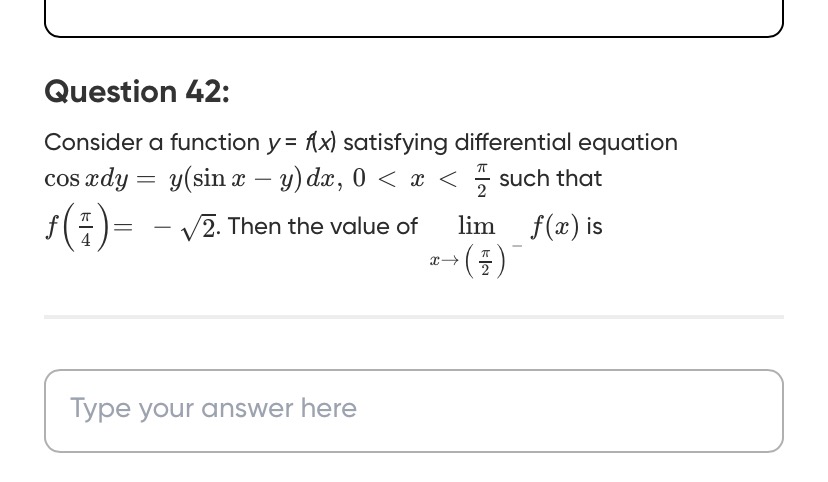Question
Question: Consider a function y = f(x) satisfying differential equation $\cos xdy = y(\sin x - y)dx, 0 < x < \...
Consider a function y = f(x) satisfying differential equation cosxdy=y(sinx−y)dx,0<x<2π such that f(4π)=−2. Then the value of limx→(2π)−f(x) is

1
-1
0
2
1
Solution
The given differential equation is cosxdy=y(sinx−y)dx. Rearranging, we get dxdy=cosxy(sinx−y)=ytanx−y2secx. This is a Bernoulli's differential equation of the form dxdy+P(x)y=Q(x)yn, with P(x)=−tanx, Q(x)=−secx, and n=2.
To solve this, we divide by yn=y2: y−2dxdy−y−1tanx=−secx. Let v=y1−n=y−1. Then dxdv=−y−2dxdy. Substituting these into the equation gives: −dxdv−vtanx=−secx. Multiplying by -1, we get: dxdv+vtanx=secx.
This is a first-order linear differential equation. The integrating factor (I.F.) is: I.F. = e∫P(x)dx=e∫tanxdx=eln∣secx∣=secx (since 0<x<2π, secx>0).
Multiplying the linear equation by the I.F.: secxdxdv+vsecxtanx=sec2x. The left side is the derivative of the product v⋅(I.F.): dxd(vsecx)=sec2x.
Integrating both sides with respect to x: ∫dxd(vsecx)dx=∫sec2xdx vsecx=tanx+C.
Substitute back v=y1: y1secx=tanx+C. ycosx1=cosxsinx+C=cosxsinx+Ccosx. y1=sinx+Ccosx. So, the general solution is y=f(x)=sinx+Ccosx1.
We are given the initial condition f(4π)=−2. Substitute x=4π and y=−2: −2=sin(4π)+Ccos(4π)1. −2=21+C211=21(1+C)1=1+C2. Dividing both sides by 2: −1=1+C1. 1+C=−1⟹C=−2.
Thus, the particular solution is y=f(x)=sinx−2cosx1.
We need to find the limit of f(x) as x→(2π)−. limx→(2π)−f(x)=limx→(2π)−sinx−2cosx1. As x→(2π)−, sinx→sin(2π)=1 and cosx→cos(2π)=0. The denominator approaches 1−2(0)=1. Therefore, the limit is 11=1.
